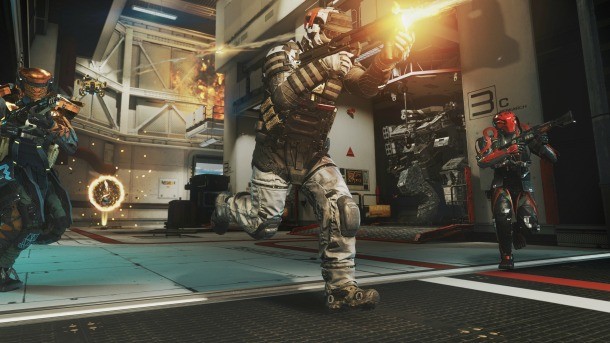Call of Duty: Infinite Warfare

The days when Call of Duty was essentially two sub-series (Treyarch’s Black Ops versus Infinity Ward’s Modern Warfare) fighting for supremacy are long gone. Since Call of Duty: Ghosts, Infinity Ward has begun building on the improvements made by Treyarch and Sledgehammer rather than attempt to carve out its own niche. With Call of Duty: Infinite Warfare, it seems more willing to do that than ever, and it might end making the series better in the long run.
Infinite Warfare’s approach to multiplayer takes a number of cues from Black Ops III. For starters, just about every mobility option from that game returns: you can powerslide, sprint along walls, and use a jetpack to give yourself a short boost. This makes Infinite Warfare feel more familiar at the outset than any Infinity Ward-made title in the series, since you don’t have to relearn your moveset for the umpteenth year in a row.
Infinite Warfare also borrows from Black Ops III’s class system. Rather than define every player simply by their gun loadout, it has you choose one of six character “Rigs,” or classes. Each Rig can choose two class-specific traits and one “Payload” super ability or weapon before going into battle. You can still choose among the series’ mainstay array of guns regardless of your class, and there looks to be more guns to unlock and build than ever (more on that in a bit). But in the hour or so I spent shooting other faceless soldiers and robots in multiplayer, I found most classes were tailored to specific playstyle.
The Phantom Rig’s perks, for example, match the sniper archetype. Phantoms can choose among marking their target after shooting them, (which highlights them for allies to see and prevents them from regenerating health), sensing when enemies are nearby while aiming down the sights of their weapon, or equipping a shield on their back which negates one attack from behind. These perks seem tailor-made for a sniper who wants to just hang back, let others finish off marked targets, and not worry too much about someone sneaking up on them.
Conversely, the FTL Rig fits a more aggressive playstyle. One of the class’ Payloads is a short-range teleport (similar to Advanced Warfare’s boost) with a relatively short cooldown, which can instantly put you in range to eviscerate an enemy with a shotgun after you spot them in a hallway. One of the Rig’s Traits, Perception, allows you to know when and where nearby enemies are looking in your direction, allowing you to quickly find your next shotgun target.
In my time with the Infinite Warfare’s multiplayer, I had a bit of trouble telling the classes amidst the chaos of combat, but by the end, I could recognize a Phantom by their futuristic ghillie suit (ironic, considering the class also focuses on stealth).

One of the new scorestreaks calls down a RC-8 robot you can either leave to its down devices or control directly.
Beyond tweaking existing systems, Infinite Warfare makes at least one contribution: the ability to craft your own guns. After each match, you’ll earn a currency called Salvage, which you can use to build your own prototype weapons. These weapons have tiers of rarity from common to epic and have perks of their own. An example gun perk, Pinpoint, creates an outline of the enemy after shooting them. You will want to level these guns up in order to get the best out of them, and they’ll also have their own unique skins and colors. I wasn’t able to mess around with prototype weapons at the press event, but I’m both curious and a little concerned about how these weapons will affect the balance of the game.
Standard, non-crafted weapons also have a few tricks of their own. Some weapons run on energy rather than bullets, and will slowly regain ammo over time. Others have multiple functions, such as a sniper rifle that can quickly turn into an assault weapon. These guns feel like an invaluable asset when enemies can approach from several angles.
I tested out these guns and classes while playing a new mode, Defender. This mode has two teams fighting for a ball near the center of the map. Having a player hold the ball gives their team points, but after about a minute, the ball resets to the center position, forcing teams to vie for the ball again. This meant there were constant firefights all throughout the map, as teams fought to both take the ball before while also attempting to secure the center point for when the ball eventually reset.
Part of me is a little wistful Infinity Ward is no longer adamant about leaving their own mark on the series they turned into a household name. But the additions and tweaks it has made to the structures and formulae established by its co-developers are smart improvements; after spending some time playing around with the various Rigs, traits, and guns, I feel like Infinity Ward will leave just enough of a mark that players will still recognize which developer’s name is on the box this year.
For more on Call of Duty: Infinite Warfare’s single-player campaign, check out our Cover Hub. The game will launch on November 4 for PlayStation 4, Xbox One, and PC.

Get the Game Informer Print Edition!
Explore your favorite games in premium print format, delivered to your door.
- 10 issues per year
- Only $4.80 per issue
- Full digital magazine archive access
- Since 1991











